A Conversation with Nauman Niaz
Martin Chandler |
Over the years some remarkable collections of cricket memorabilia have been put together. Sadly for we mere mortals these are generally in private hands, so we do not get to see them. There are museums of course, that at Lord’s being one I have been to on a couple of occasions but, my main interest being the literature of the game, those trips have not been entirely fulfilling.
David Frith had a stunning collection of all types of memorabilia, including books, pamphlets and the other printed ephemera that fascinate me so much. That collection is being broken up as I type this feature, the first tranche of it having gone under the hammer in March this year. But at least I will always have my copy of that weightiest of tomes, The David Frith Archive, so whilst I will never smell, see or touch the Frith collection I can at least marvel at the breadth of its coverage of cricket history and picture it in my mind’s eye.
Only one other collection has been the subject of a similar project (ironically enough by the same publisher) and that is the subject of the two volume Collector’s Eye, published in 2021. That collection is still growing and, given it is located in Islamabad, it is just as well that it is illustrated so extensively in Collector’s Eye. To add to my pleasure on that subject the collection’s fortunate owner, Nauman Niaz, is kind enough to send me occasional updates on the subject of his latest acquisitions.
Previous generations have had their remarkable collections as well. Pat Mullins and Tony Baer assembled them in the latter years of the twentieth century, and before them there were the likes of Joe Goldman and Sir Julien Cahn and, for anyone interested, there is some evidence available of the items all of them owned. Indeed in the case of Mullins and Baer their collections now repose at the Melbourne Cricket Ground, so are available for public viewing.
But none of the collections I have mentioned were assembled in the same way as Nauman’s. The man is a genuine polymath, as is inevitably going to be the case with a man who has got so far in life in so many different fields of human endeavour. Cricket may be his first love, and all in all he tells me that cricketing items make up around half of his personal museum, but there are many other remarkable items in there.
So what else does Nauman collect? It needs to be mentioned briefly if only to give an idea of the range of his interests. Thus the very first ‘exhibits’ in Collector’s Eye are a selection of signed photographs. You might expect to see the likes of WG Grace, Fuller Pilch, Ranjitsinhji and John Wisden, but in fact those featured are Adolf Hitler, Erwin Rommel, Abraham Lincoln, Marilyn Monroe, Winston Churchill, King George VI and Diego Maradona. A measure of just how impressive Nauman’s museum is is the look of awe in the facial expressions of the men in this photograph. Ordinarily none of Ian Chappell, Vivian Richards or Rashid Latif are, I would imagine, easily impressed and, showing them round, even Nauman’s face betrays a sense of wonder at what he has been able to put together.
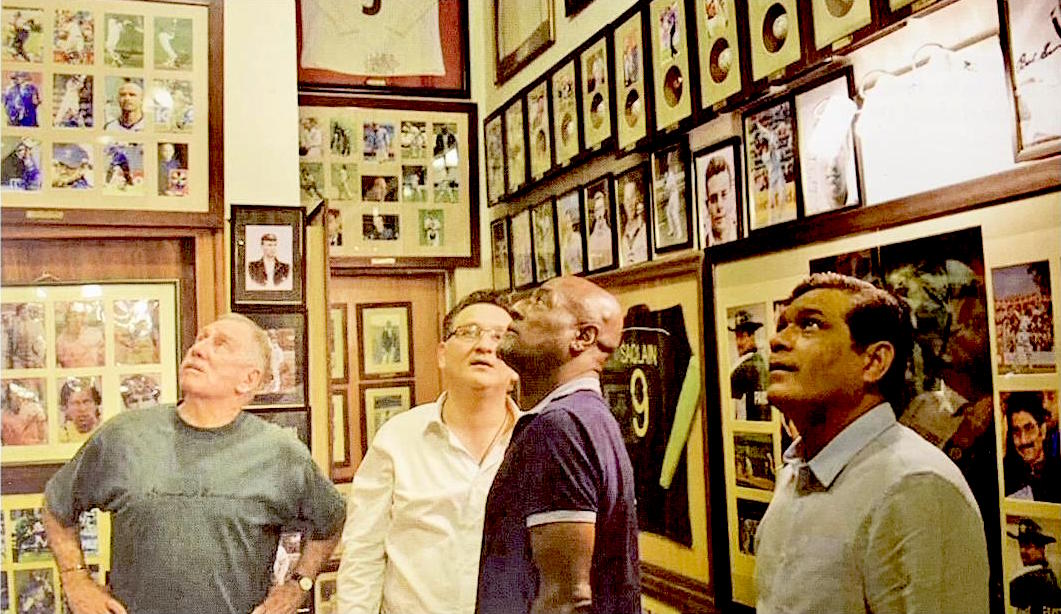
So now you have an idea of the sort of man I am dealing with, and the difficulty of the task of confining oneself to just a few questions. But the advantage of the internet is that we can have as many instalments of this conversation as Nauman is prepared to indulge me for, so here’s the first set of questions and Nauman’s responses;
At what age did you start collecting and what was the first area of interest attracted your attention?
From a very young age I was into preserving anything that belonged to me, unlike other contemporaries or children, I cleaned my toy cars and kept them in special pouches. I also preserved my quarterly report cards at school, even the sharpened pencils. I don’t know whether it was hoarding or sense of ownership or a tool of keeping the memories alive.
I was seven years old when I first saw live cricket, the first Test between Pakistan and New Zealand held at Lahore’s Gadaffi Stadium. Javed Miandad made his debut and posted an impregnable 163. I had a match brochure in my hand which I got signed not only by Javed but the entire Pakistan team and also all the New Zealand players.
It was at around this age that my maternal uncle, himself a Ranji Trophy player and a First Class cricketer, Khawaja Rauf Zakria Kitchlew, presented me with two books. One was a first edition of the Jubilee Book of Cricket by Shri Kumar Ranjitsinhji that was published in 1897, and the other an impeccable copy of Imperial Cricket by Sir Pelham Warner that was published in 1912. I kept them near my pillow and hardly slept that night.
My mother, who had been a regular as a spectator to almost all the matches played at Lahore’s Bagh-i-Jinnah, gifted me her autograph book which contained autographs of the 1951 MCC team that toured Pakistan. It was also signed by the Pakistan team which travelled to India for their inaugural Test series in 1952-53, the India team that arrived in Pakistan in 1954-55, and the New Zealanders who came to Pakistan in 1955.
Even those gems weren’t the entirety of the treasure trove, which continued with the signatures of the MCC ‘A’ team led by Donald Carr in 1955-56, the Australians who visited in Pakistan 1956, the West Indians who came in 1958-59 and the 1959-60 Australians. After that I began collecting the autographs of all First Class cricketers, and having photographs signed on match brochures and magazines. I was twelve years old when it all started. There was no looking back. So I had begun as an autograph collector, and the books followed, those I began acquiring by the time I was thirteen years old.
Did the rest of your family encourage you, or did they just let you get on with it?
Pampered and loved unconditionally I was encouraged by my family who fully endorsed my passion. My father incentivized it all. If I got A grades at school, I was gifted a handful of cricket books and so on. As explained, even my maternal and paternal uncles spurred me on.
We have already established your collecting tastes are an eclectic mix, but I’m a cricket lover so tell me what your main interest is, and has that changed over the years?
You are right that my tastes as a collector are an eclectic mix, however I am deeply into pre-war and the Edwardian age memorabilia primarily the signed postcards, the autograph sheets, and rare handkerchiefs. Yes, over the years it has changed and the choices have transformed. I now seek out first editions of the rarest books, preferably inscribed or signed, and prints from the likes of JC Anderson, George Beldam, Chevallier Tayler as well as match used bats and other equipment, even stumps.
And now I’m going to break some bad news Nauman – any moment your museum is about to fall victim to a natural disaster – do you stay with your treasures and face whatever is coming or flee with what you can carry?
I’ll stay with my treasures and face whatever is coming.
I was very confident that would be your response, and I would like to think I would do the same. So let’s pretend, just for a moment, that you decide on flight. I am going to allow you to take ten items with you. What are they going to be?
That is a cruel question, but in the spirit in which you ask it I will reply. I think I would try to preserve the following:-
- Felix On The Bat inscribed and hand-signed by the author (1845)
- Presentation Copy of WG Grace’s Cricket published in 1891 (one of the ten printed)
- Hand-signed Lillywhite’s Scores & Biographies Volume I & II (hand-signed by Fred Lillywhite) in 1862.
- Victor Trumper’s match played bat from 1899 (Lord’s Test)
- Sir Donald Bradman’s match played bat
- Australia to England in 1909, large original hand-signed photograph
- MCC to England 1907-1908 hand-signed team photograph
- Match used bat of W.G. Grace 1905
- Match used bat of Shri Kumar Ranjitsinhji 1896
- The original ball used in the 1902 Test between Australia and England where Gilbert Jessop walloped a match winning century.
Which does include three books, but as a bibliophile that is my main area of interest, so I decided to dwell on the point and asked Nauman to tell me about some more of his books. I gave him a wide brief, but stressed that I wanted him to include not only his treasures, such as the three books he had already mentioned, but also his favourite reads. In the end he came up with fifteen more titles. They are an interesting selection, and in no particular order are:-
Kings of Cricket by Richard Daft (1893)
This is a book I have written about before, here, so will not go into detail again. Nauman’s is number six of the subscriber’s edition.
The Cricket Field by James Pycroft (1922)
One of the early books on the game the first edition of Pycroft appeared in 1851. Between then and 1887 the book ran through eight more UK editions as well as one in the US. A final edition, edited by Ashley-Cooper was published in 1922. It may seem surprising that Nauman’s copy is of the last rather than the first edition, but then only the 1922 version appeared in a special limited edition. Nauman’s copy is number 60 of the 100 published
Beyond a Boundary by CLR James (1963)
The greatest cricket book ever published? There have certainly been plenty who have made that claim and it is a book that Stuart Wark reviewed here, and I subsequently wrote about here. I dare say that it is the famous essay on WG that attracts Nauman as much as anything, and he has a very special copy. It is a first edition of course, desirable enough in itself, but this one is inscribed from James to G Neville Weston, a noted collector and great expert on WG.
Scores of Matches 1786-1822 by Henry Bentley (1823)
One of the first books published on the game Bentley is nothing more than a collection of scorecards, and rudimentary ones at that. It is nonetheless one of the most sought after items of cricket literature particularly, as Nauman of course has, a copy with the two supplements for 1823 and 1824/25 present. For we mortals however there is a most attractive facsimile that was published by Roger Heavens in 1997, and which has the added benefit of a scholarly introduction by David Rayvern Allen.
A Few Short Runs by Lord Harris (1921)
The autocratic Harris is best known as an administrator, but he was also a fine player who led England in four Tests against Australia and this is his autobiography.
An Australian Cricketer on Tour by Frank Laver (1905)
Before the format for tour books became set in stone Australian all-rounder Frank Laver wrote this excellent account of his trips to England with the 1899 and 1905 Australians.
With Stoddart’s Team in Australia by KS Ranjitsinhji (1898)
Thanks in large part to Ranji’s 175 England won the first Test of the 1897/98 Ashes series but, sadly, despite the great man ending the series with an average of 50 England lost the other four Tests. After returning home Ranji produced this classic account of the trip.
Stray Thoughts on Indian Cricket by J Framjee Patel (1905)
This was the first book published that looked at the history of cricket in India in the round. A few earlier books had been written, but they concentrated on the game amongst the Parsi community. Patel’s book is available to all as a reprint. Nauman’s copy however is, of course, a first edition.
With the MCC in Australia by Philip Trevor (1908)
This book is the only account of the 1907/08 Ashes series. It was printed on poor quality paper and few copies survive. Nauman’s is of course an original, but thanks to UK dealer/publisher JW McKenzie a modern facsimile is available.
Memento of Arthur Shrewsbury and Alfred Shaw Cricketers by WF Grundy (1907)
A modest 93 page book this one pays tribute to two of the greatest English professional players of the ‘Golden Age’ being the Nottinghamshire pair of Shaw and Shrewsbury. The former, a formidable bowler, had died just before publication and Shrewsbury, a fine batsman, had taken his own life four years previously.
‘WG’ by WG Grace (1899)
This was the great man’s autobiography, a bulky 524 pages ghost written by Arthur Porritt. Nauman’s copy has a most remarkable survivor for an 1899 book, its original dust jacket.
10 for 66 and all that by Arthur Mailey (1958)
Well received on publication in 1958 the reputation of this entertaining memoir from Australian leg spinner Arthur Mailey has, unusually, grown over the years.
Lambert’s Cricketer’s Guide by William Lambert (1816)
Books of this age are either poems, collections of scores or instructional, and Lambert falls into the latter category. It appeared in at least 13 editions, including what was described as a 20th, although no copies between 13 and 19 have been recorded. All incarnations of the book are, unsurprisingly, exceptionally rare. Nauman’s copy is one of his more recent acquisitions, and a second edition.
Curiosities of First Class Cricket by FS Ashley-Cooper (1901)
Many of Ashley-Cooper’s publications are difficult to acquire, often appearing in short runs of just a few copies. Curiosities of First Class Cricket, as its title suggests, is an entertaining collection of the bizarre and unusual stories about the game that Ashley-Cooper tracked down in his extensive research into the history of cricket, and is one of the easier of his titles to source. That said there was a limited edition of 100 signed, numbered and specially bound copies, of which Nauman’s is one
Alfred Lyttelton: His Home Training and Earlier Life by Edward Lyttelton (1916)
Alfred Lyttelton was a double international, representing England at cricket and soccer, and is best known for taking off his wicketkeeping kit in 1884 and taking four Australian wickets in quick succession with his underarm lobs. A career politician in 1917 Lyttelton’s sister, Edith, wrote a full biography. This one, much slimmer and much rarer, was written by brother Edward, also a soccer international, a First Class cricketer and for his day job long time headmaster at Eton College. The value of Nauman’s copy of the book is greatly enhanced by being accompanied by a lengthy letter from the author to a member of the Hunter Blair family.
Which I think concludes how much I can pester Nauman about his collection at this stage, but rest assured that I will do my best to get him back for another session in the near future.
But finally, having whetted the appetite of all who are reading this, to be going on with here are just a few images of Nauman’s museum.


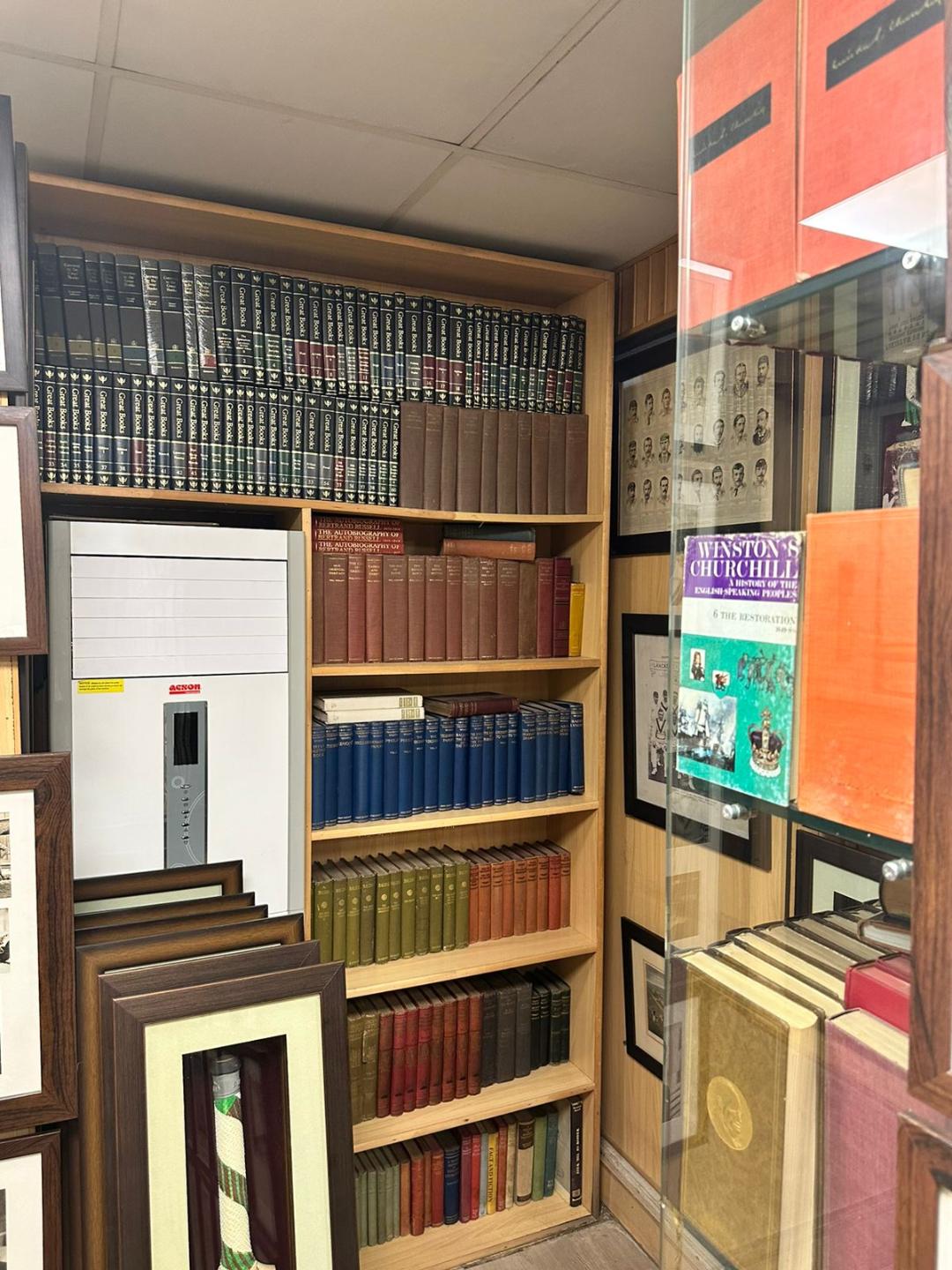
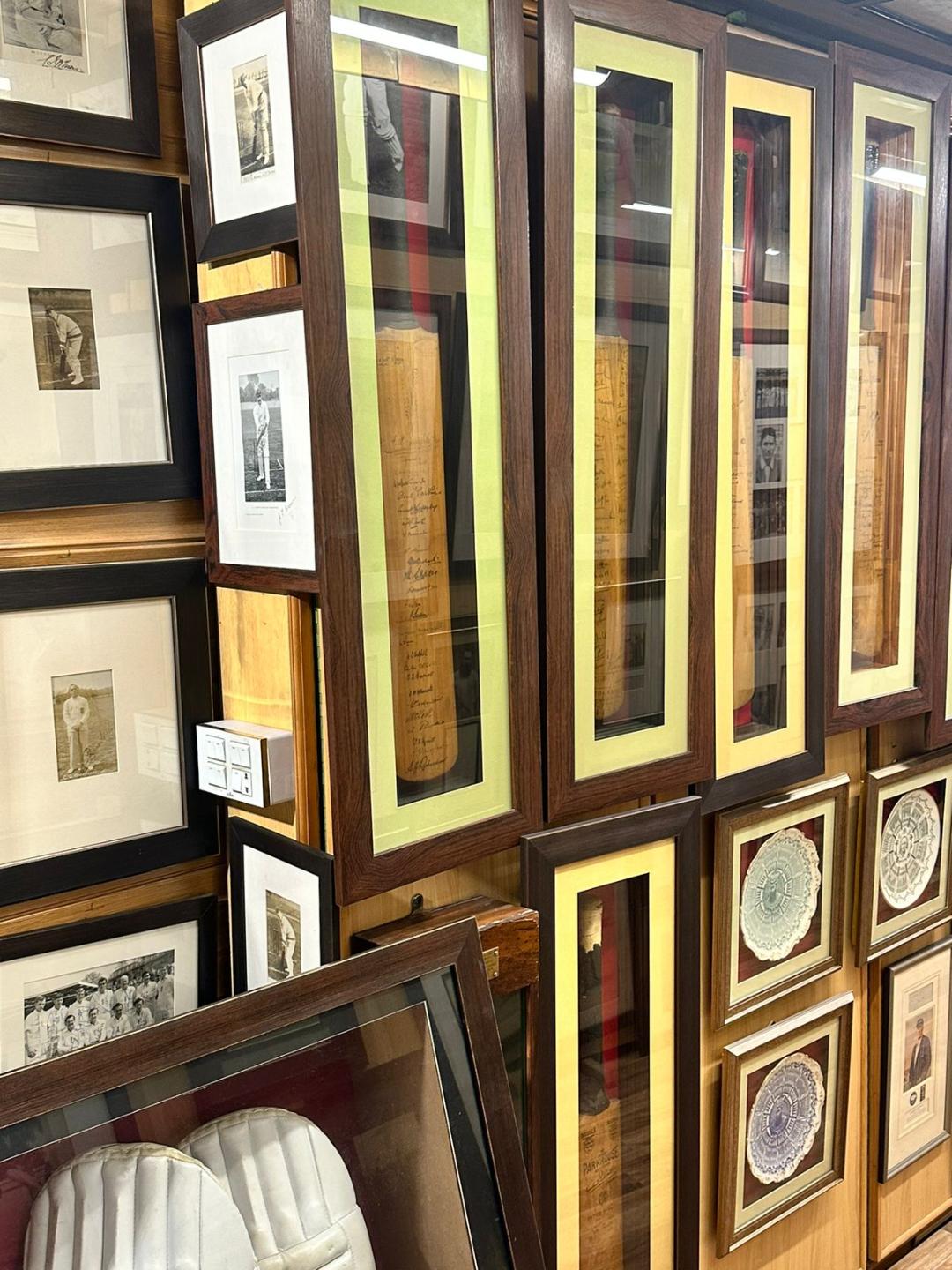

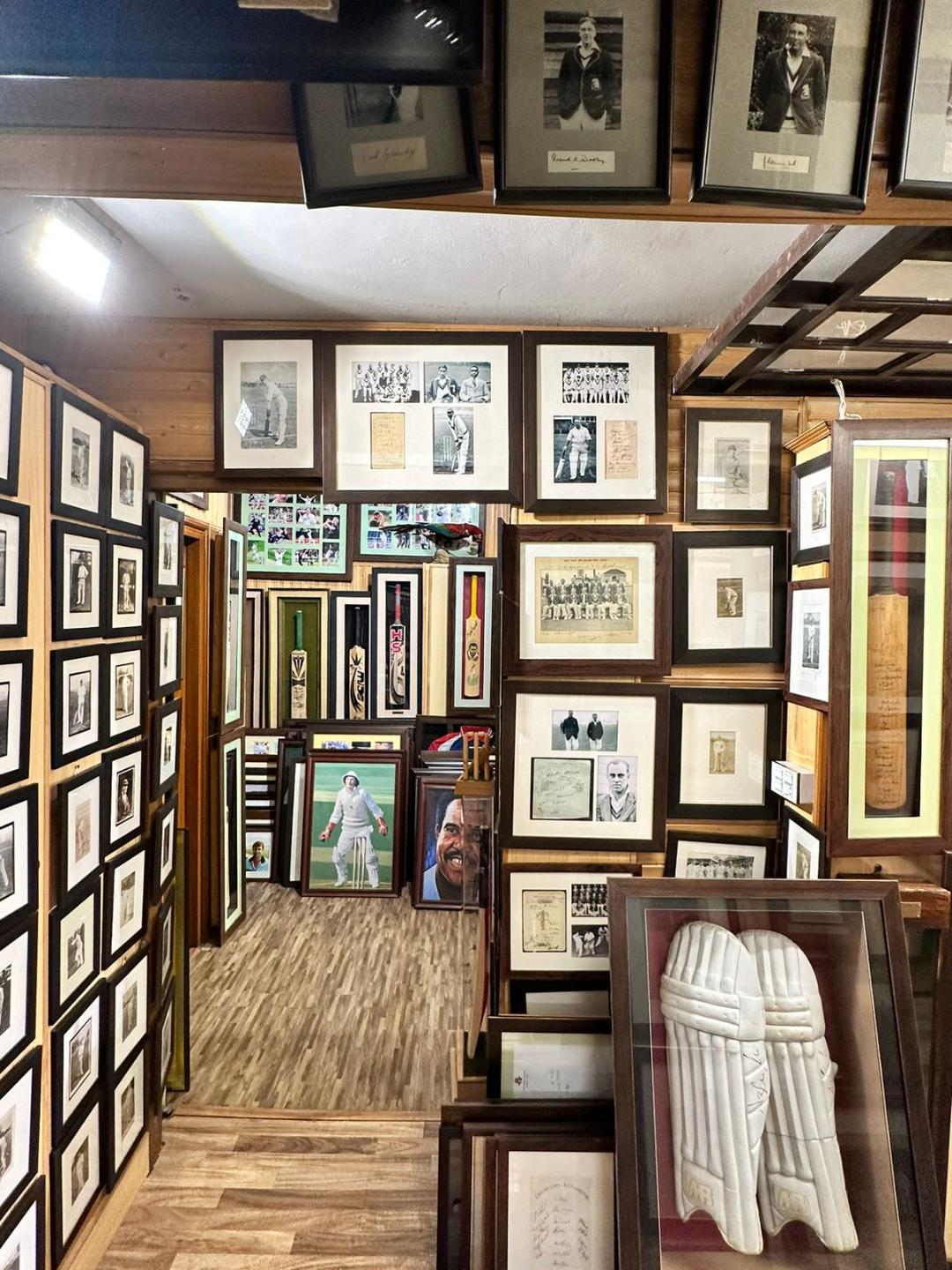

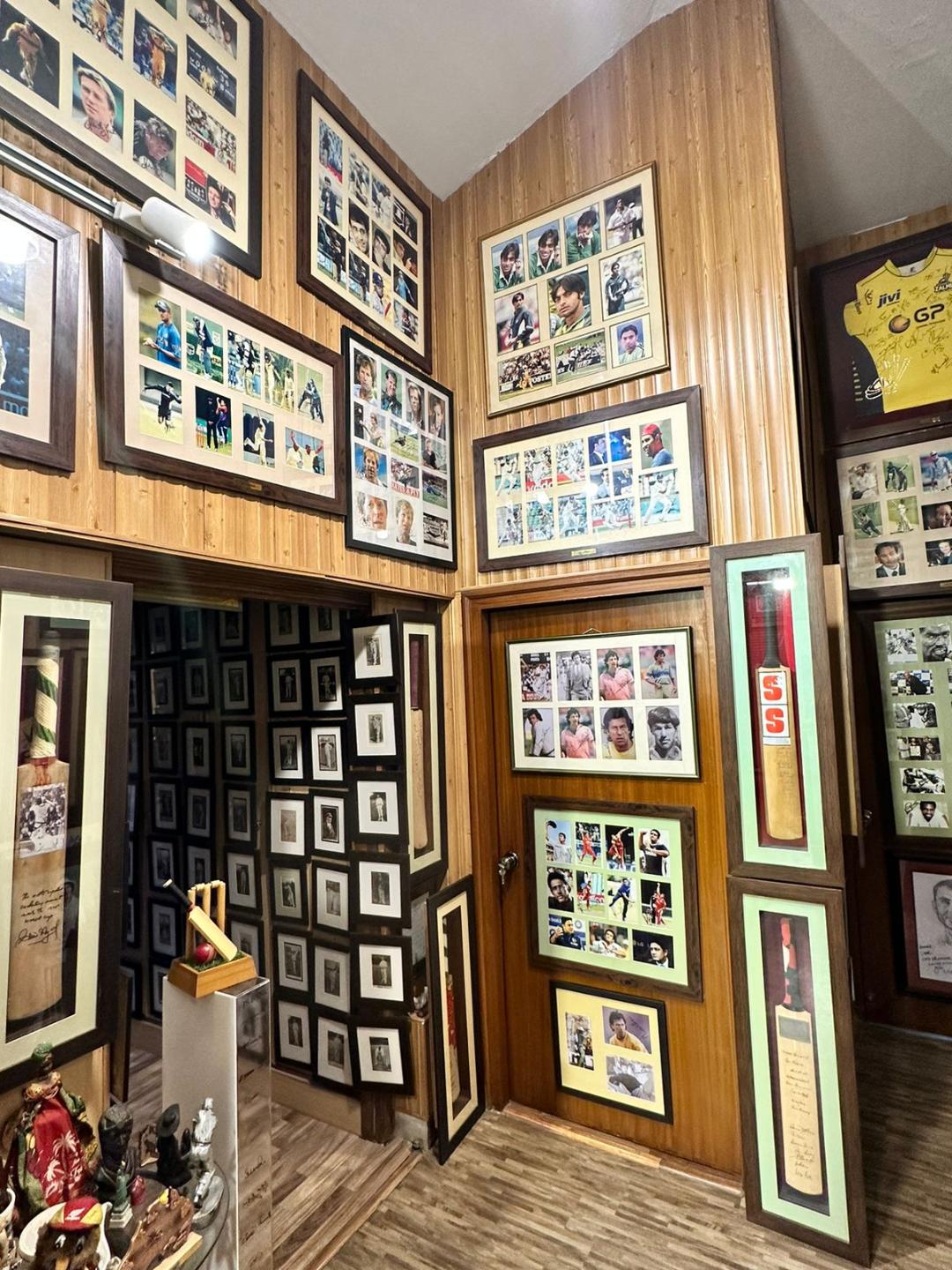

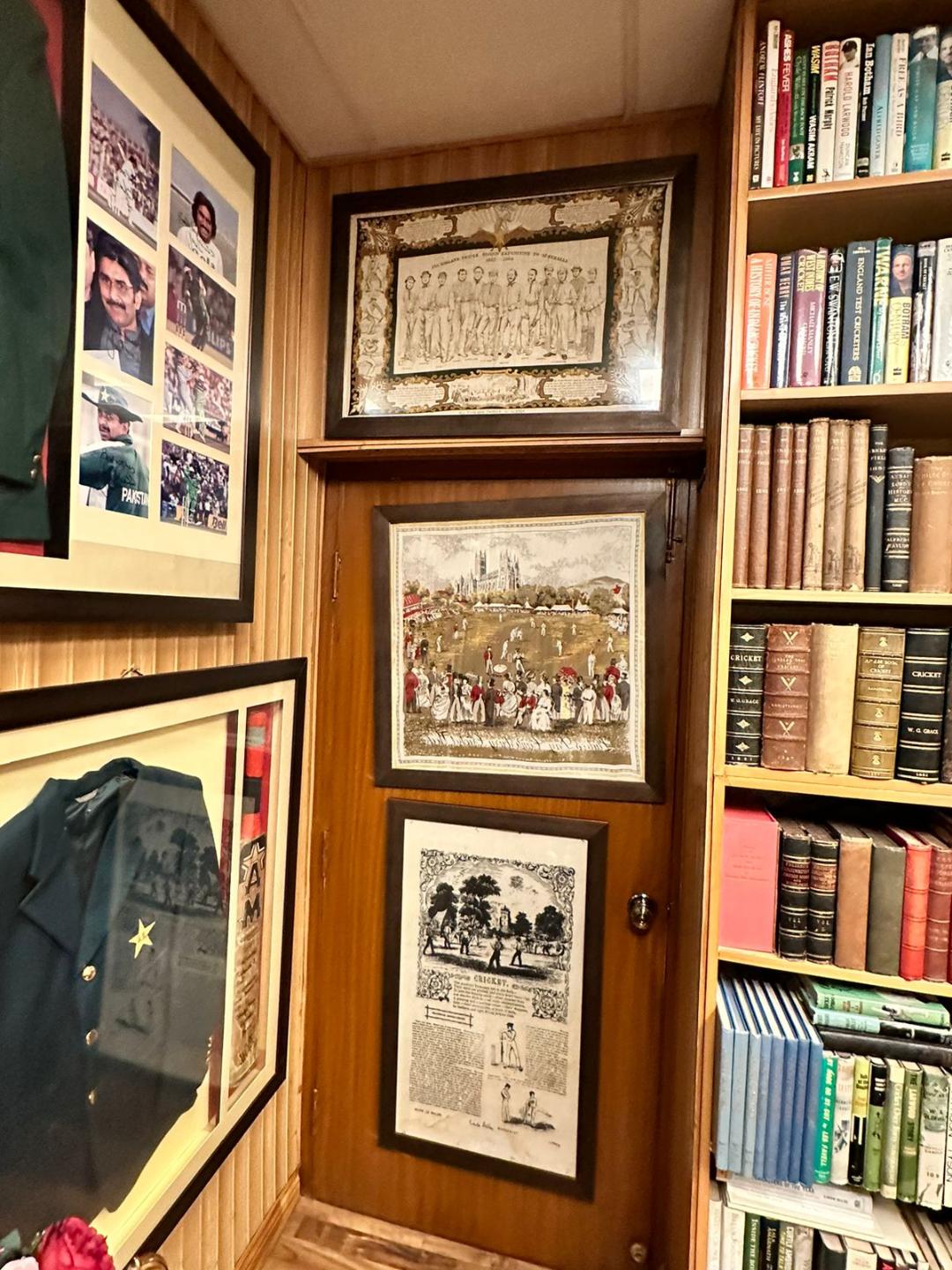

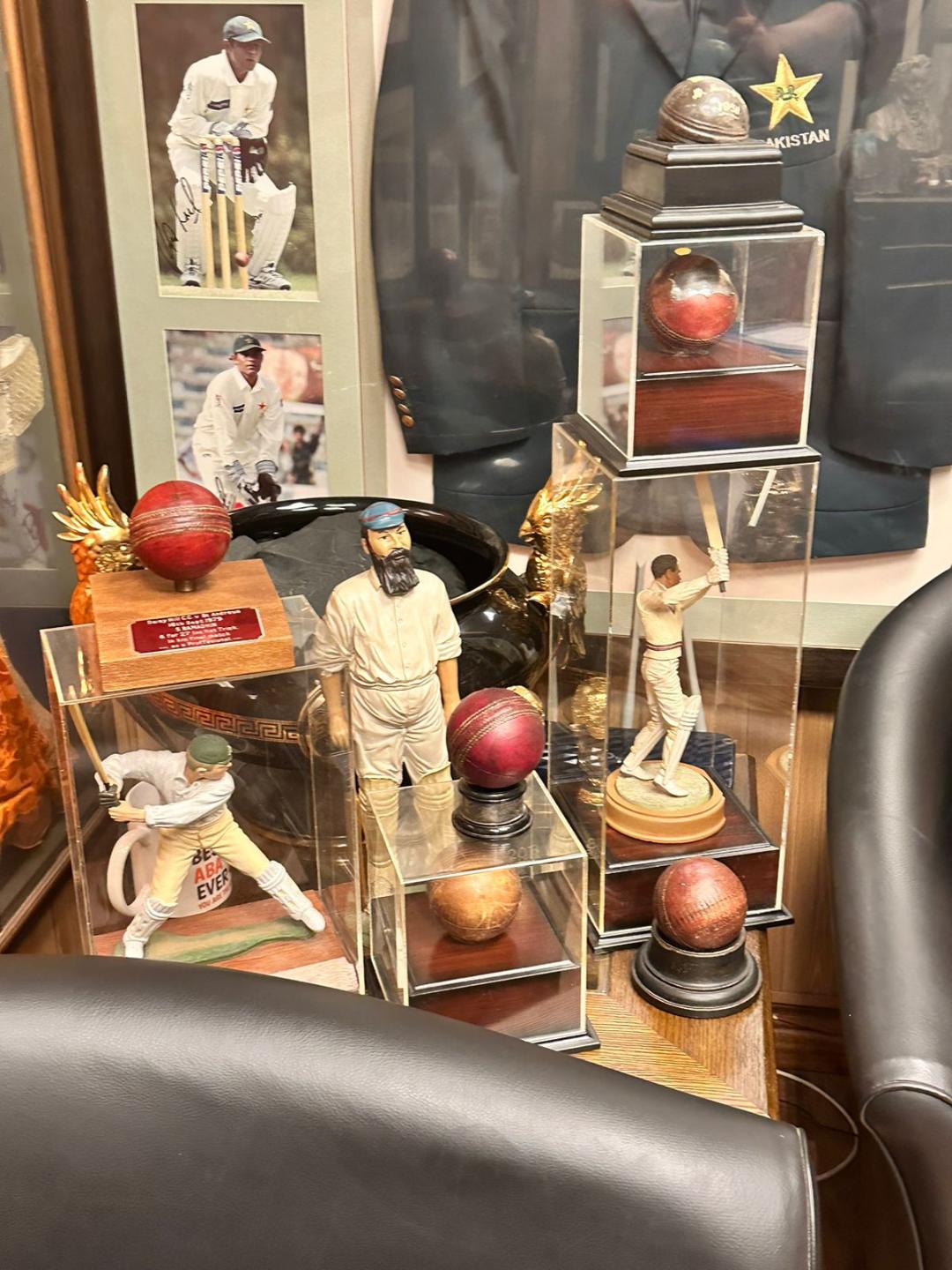
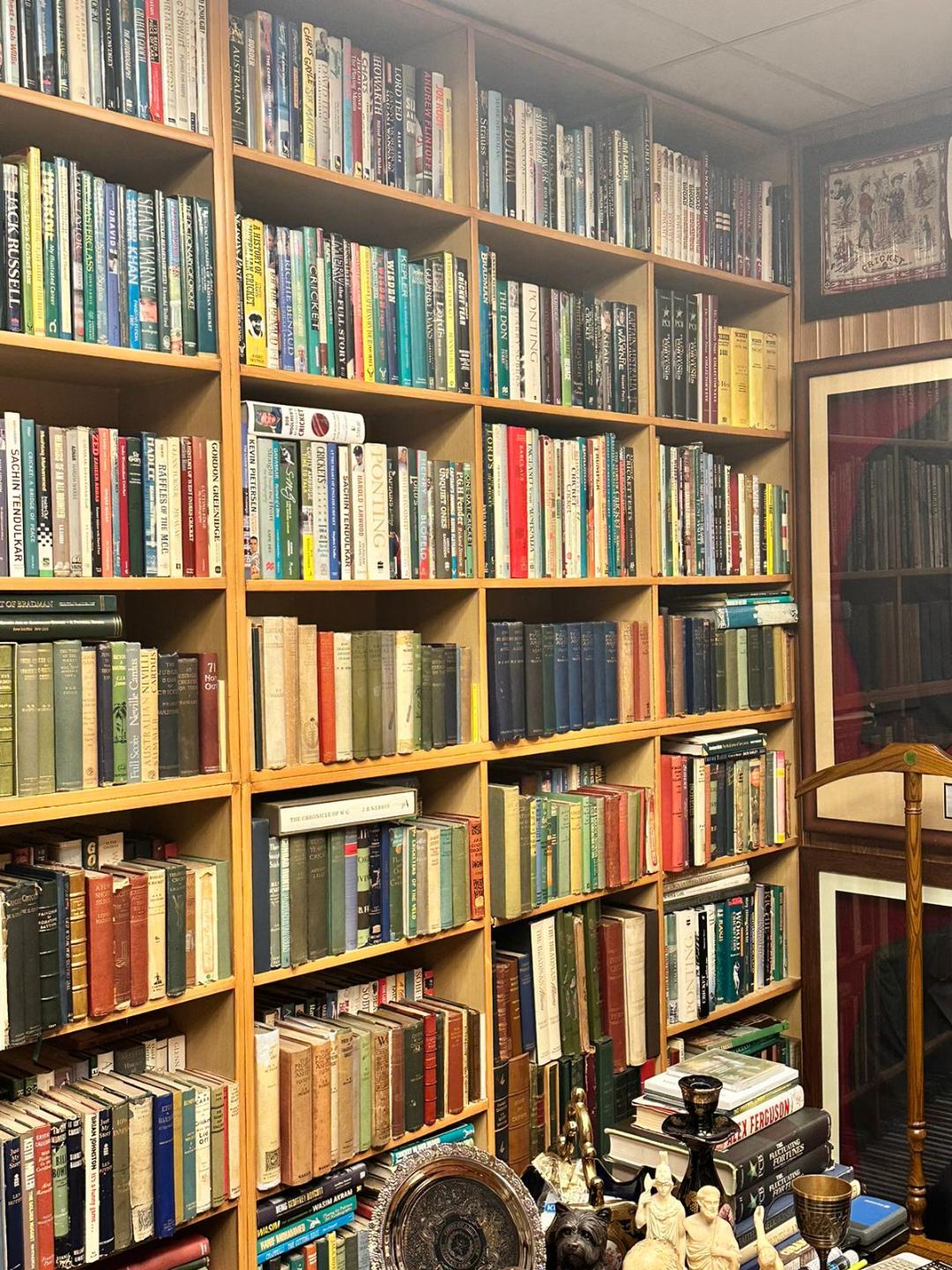




Leave a comment